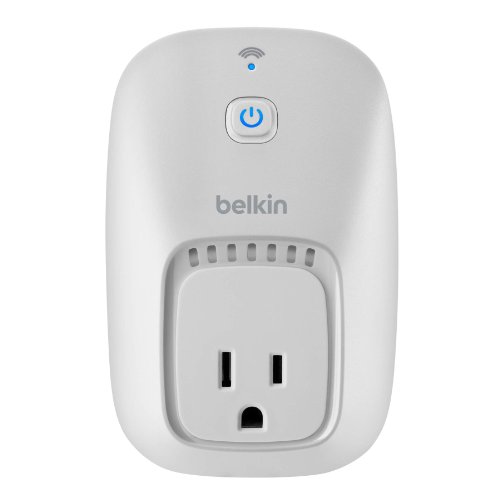The Belkin WeMo Switch, the iPhone Home Remote, works with the (free) WeMo app so you can turn electronics on or off from anywhere. A lamp, a fan, a heater, curling iron, stereo, you name it. If you can plug it in, you can control it with WeMo. You can turn your electronic devices on or off, you can even put them on a schedule. You’ll save time, and save money by conserving energy. WeMo uses your home Wi-Fi network, and also operates over mobile internet-so you can even control things while you’re away. WeMo is completely modular, allowing you to control as much or as little of your house as you like. WeMo is your home at your fingertips.
Product Features
- Use motion to turn electronics on or off – from anywhere
- You’ve already got everything you need: WeMo works with your existing Wi-Fi router and any Apple iPod touch, iPhone, iPad – iOS v5 or higher.
- Modular system. You can add additional WeMo Switches and WeMo Motion sensors easily, any time. Control as much or as little of your house as you want to.
- Operates over Wi-Fi and mobile internet, at home and away.
- Included: WeMo Switch






I really like this… but it isn’t for everything… I should note, I have several IP Power Switch boxes. I use them for things like controlling my network, network devices and stereo devices. These work off of wired ethernet, and have many plugs on the back that are addressable. I note this only to make clear I already understand some of the shortcomings of these types of devices.OK, that said, these are really nice for the right application.Power ThroughputFirst, since I searched high and low for this information (on Belkin’s site – everywhere) and could not find it… the device packaging indicates that it can handle 15A throughput. Amazon should really add that to the product description, since I consider it pretty important.Setup (MAC address printed on the back is wrong)There is a trick in the setup and it ended up wasting about an hour of time. That is, the MAC address written on the back of the device is off by one. I’m guessing that is because it probably has 2 wi-fi network cards in it. I’ll note that in a second. But, if you have your wireless network setup to filter by MAC address, the address printed on the back is off by one… so add one to it for the wireless network you will need to “filter” (and for those not technical, remember it is HEX, so one more than 9 is A, and one more than F is like adding 10). you can use a hex calculator on the internet if that isn’t enough. I won’t bore you with how I figured this out… and they may change it at some later date, but that is the current situation.Setup (Aside from the wrong MAC address)It is (in my opinion) really nice. I think they have 2 wi-fi adapters in the device, because you first setup your iPhone (or other iOS device) to connect to the switch. I was assuming once you connected through the iOS app and entered your network information, you would loose connection and just have to assume everything worked, as it switched the single wi-fi adapter’s settings and connected to your wifi network. But, conveniently, it stayed connected to my iPhone, helping diagnose the problem… thus I figured there were 2 wifi adapters. I think this is a really nice touch – and will really help. Kind of nullified by putting the wrong adapter’s MAC address on the back of the device – but, we all make mistakes. The setup otherwise went smooth.WAN SetupEffortless – I did nothing. No router settings, technical people will understand the weakness of this approach, but for everyone else, it is mindless… just worked.IFTT (If This Then That)Is a website not associated with Belkin other than that it supports their device. You should note, it only supports a single device currently. So, you can’t get too complicated, but it does not it will support more than one at some time in the future. I really like this function. There is a fair amount of capability when a sensor is triggered (if you have the sensor device), or a switch was turned on/off. You can tell the IFTT website to do something, like send you and email notifying you of such. And conceivably significantly more at some point in the future.How it WorksThere is a nice iOS device that reports the state of the device (currently on or off, or in the case of the motion sensor sensing motion or not sensing motion). In the case of the power switch, you can change it’s state from the iOS device or by pressing the “override” button on the device itself.” In the case of the motion sensor, you can tell it what to do when motion is sensed… like power on a switch. It should be noted, the sensor and the power switch are two separate devices. The power switch that comes in the motion sensor pack, is the same power switch you can buy individually, and neither the sensor or the power switch are tied to each other specifically. That is to say, the motion sensor can control any belkin switch. It has a lot of potential.How it Doesn’t WorkIt seems to have the same weaknesses that any wireless network device has… loosing connection after long periods. This may well be fixed in a firmware updated, but for me, right now, the power devices seem to crash after being plugged in for a couple of days. I had it on a nite light in our hall (just to test reliability). I setup a schedule to turn the light on at dusk and off at sunrise. Pretty simple, and something you’d want to work before heavily investing in them. It works for 2 or 3 days, then “hangs.” Doesn’t show up in the iOS app, and won’t respond to the button on the device. After pressing the button, it would “reconnect” to the network after a minute or two, and be fine for another couple days. This didn’t just happen once. Also note it is located in an area where the network has solid strength (current version Apple Time Capsule). Also, my wireless network is not setup directly to a cable modem… I have a router between, so the wireless network stays up…
Exactly What I’ve Been Looking For! I’ve been on the hunt for the past few months now for a cheap solution for home use that’d allow me to kill power to my home “server” and then bring it back since it’s set to auto power on after power failure.I work in IT and have used APC’s IP managed powerstrips many times but they’re a small fortune when the money is coming out of my pocket and not being used for Data Center build outs.I’ve looked high and low and almost went with a few other options that’d of required me to SSH or Telnet into the device then send the kill command to it.While that’s fine for someone like me, everything I found cost at the very least $100 and often much more.This product is brainlessly simple to set up (if you actually follow the instructions!) and just works.I did a few test both while on my home network wifi from my iPhone and also while on 3G to ensure the outside connectivity was working properly and every time it worked without issue.FINALLY I can force off my home server when I’m away and bring it back up in the (rare) event it locks up!!
Great product but setup can be tricky. While I am not an IT administrator, I am the person friends and family come to with computer and home network issues. That being said, the setup of the first outlet was very simple and everything worked as should. After over an hour of changing network settings, restarting the device and following all of the other hints from the website, I still have not been able to get the second outlet to show up on the app. This product is not ready for the mainstream yet – pretty disappointing for a Belkin product as most of their products that I have used work very well. I will probably return both as I want to use one app to control all of my outlets and lights.UPDATE: Finally got both of them working after multiple resets and deleting the app on the iphone and then re-downloading. Once the firmware updates were applied to both outlets things started to work. Now that it is working I am quite happy with it.
Comments are disabled for this post.